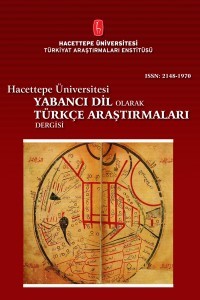YABANCILARA TÜRKÇE ÖĞRETİMİ İÇİN YAZILAN DERS KİTAPLARINDAKİ BULMACALARIN İŞLEVLERİ VE ÇEŞİTLİ AÇILARDAN DEĞERLENDİRİLMESİ
Öğretim ortamlarında bir etkinlik olarak yer alan bulmacalar, hem bireysel olarak hem de grup içindeki etkileşim ile öğrenmeyi kolaylaştırabilen etkinliklerdir. Bulmaca etkinlikleriyle dil öğretmenin, öğreniciyi konuya odaklayabileceği ve öğrenicinin başarıya ulaşmasında destek olduğu düşünülmektedir. Dolayısıyla bulmaca etkinlikleri, bireysel veya grup hâlinde yapılan uygulamalarda kullanılabilen, hem bilgi düzeylerini ölçmede hem de konu sonlarında uygulanışlarıyla öğrenicinin eksiklerini tamamlamada yardımcı olan etkinliklerdir. Bulmacaların yabancı dil öğretimine en büyük katkısı kelime öğretimi ve öğretilen konuyu tekrar etmedeki işlevidir. Kelimelerin zihinde kalıcılığını arttırdığı bilinen bulmaca etkinliklerinin bu öneminden hareketle yetişkinler için set hâlinde yazılan yabancılara Türkçe öğretme amaçlı ders ve çalışma kitaplarındaki bulmaca etkinliklerinin işlevleri, çeşitli açılardan incelenmiş ve tartışılmıştır. Bulmaca etkinliklerinin ders ve çalışma kitaplarının düzeylerine göre bu kitaplarda yer alma oranları, yer verilen bulmacaların türleri, veriliş yeri, amacı, düzeylere uygun olarak seçilmesi gereken kelimelerle oluşturulması açısından uygunluğu, hedef kültür aktarımı, hangi dil becerilerine yönelik olarak hazırlandığı incelenerek bir içerik analizi çalışması yapılmıştır. İncelenen ders ve çalışma kitaplarında genel olarak bulmacalara yer verme oranının çok az olduğu, bulmaca türlerinden daha çok sözcük avı ve zincir bulmacanın tercih edildiği, kelime öğretimi, hedef kültür aktarımı açısından az sayıda örnek bulunduğu tespit edilmiştir. Bunun da yabancılara Türkçe öğretimi ders ve çalışma kitapları için önemli bir eksiklik olduğu düşünülmektedir
Functions of Puzzles in Turkish Language Textbooks for Foreigners and
Evaluations for These Puzzles from Different Perspectives
In language teaching environments puzzles are utilized as activities, which make learning process easier via interactions either individually or in groups. It is considered that teaching languages with puzzles helps the learner focus on the subject and support their language achievements. Therefore, puzzle activities, which can be used individually or within group environments for different applications, are the ones that help learners identify and fix their inadequacies by being used at the end of each unit, as well as help instructors test and measure their levels of knowledge. The most important contribution of puzzles to language teaching process is its function to help students repeat the topics. Puzzles are also known to improve the ability of memorising vocabulary; therefore, the functions of puzzles in Turkish textbook sets for adult foreign learners, edited by Turks, have been widely studied and discussed. In this study, content analysis has been made in order to uncover the frequency of placement of puzzles in textbooks and exercise books in relation to the levels of the books; moreover, the types of puzzles chosen to be included in these books, the location and the aim of the puzzles, the relevancy of the words employed in puzzles, which should be chosen according to the levels of the books, the ability of puzzles in culture transference and which language skills are being targeted by the puzzles are also among the studied topics. The study on text books has shown that puzzles are very rare in these books. When puzzles are employed in textbooks it is seen that chain puzzles and word hunt puzzles are preferred rather than other types of puzzles and also there are very few examples that are provided to help transfer the culture and teach the necessary vocabulary. It is thought to be a major shortcoming for Turkish text books and workbooks for foreigners
